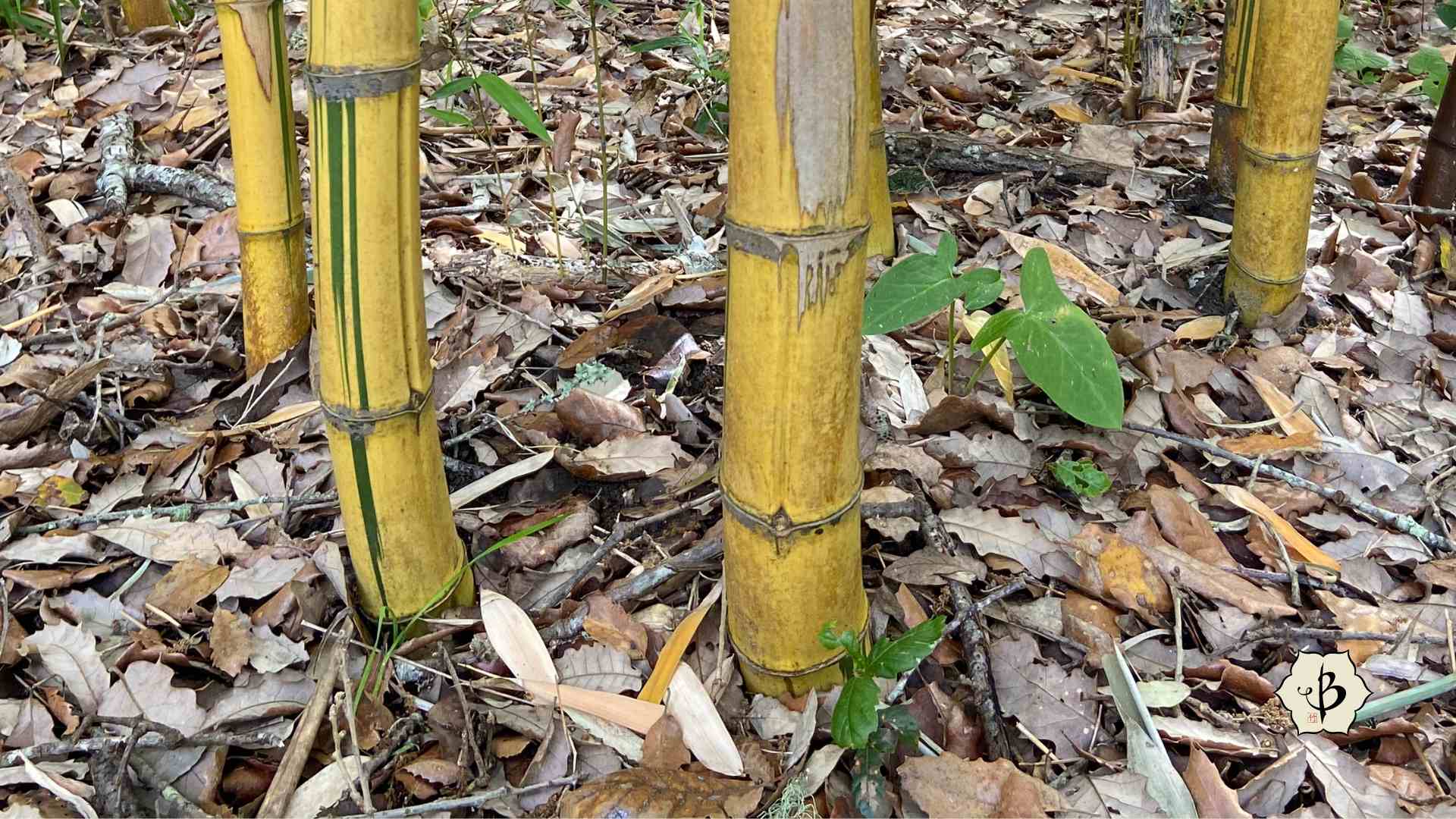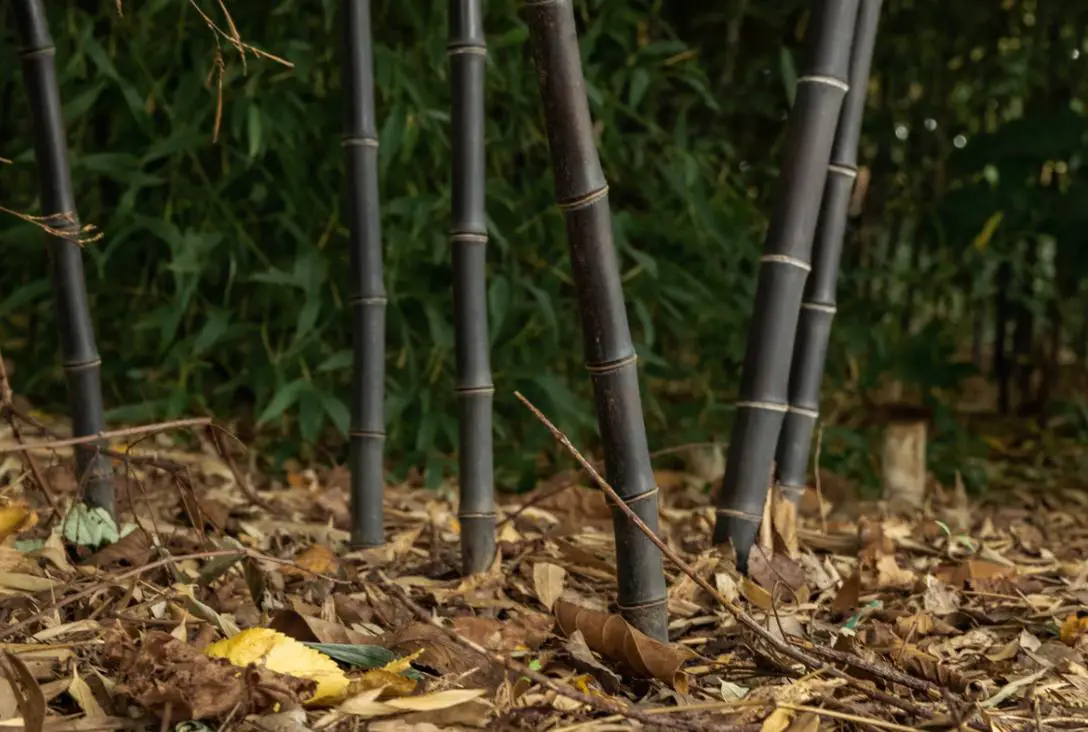If you’re living in an area with definite seasons and freezing winters (not Coastal California), then now is the time to start bracing yourself for the cold. Be sure you have enough firewood on hand, begin to think about changing your tires, and start to winterize the garden. Early autumn is also a good time to prepare your bamboo for the winter. So what’s the best way to do that?
When it comes to preparing your bamboo for winter, the single most important thing you can do is provide a good thick layer of mulch. This can include any combination of bark, wood chips, leaves and even pine needles. The mulch will act as an essential insulation that protects the bamboo roots and rhizomes from the freezing cold, while also helping them to retain moisture. Bamboo may seem like a tropical plant, and in fact a lot of species will not tolerate freezing temperatures. But there are plenty of types of bamboo that are cold hardy down to 0º F. Some are even hardy to -10 or -20º, and a good layer of mulch will certainly help them through the coldest winter nights. Potted bamboo plants present an extra challenge in the winter, and they might need to be temporarily relocated.
NOTE: This article first appeared in September 2020, most recently updated in June 2024.
Winterize your bamboo
Getting your bamboo ready for the winter isn’t difficult. In the following article, we’ll explain the basic methods. But one of the most important factors will be to choose the right variety of bamboo in the first place. So we’ll also discuss the difference between tropical and temperate bamboo, and provide some recommendations for the most cold hardy varieties.

Mulching bamboo for the winter
A heavy layer of mulch, up to several inches thick, is the best thing you can do to keep your bamboo happy through a cold, snowy winter. Like a thick blanket, the mulch will protect the soil and the roots of the bamboo, keeping them warm. A good mulching has the added benefit of holding the moisture in the soil, preventing it from drying out when it gets especially cold and windy. Of course, water retention will also be important in the summer, when the weather turns hot and dry.
Bamboo is resilient, and you don’t need to be overly cautious in selecting your mulch material. The natural leaf drop from the bamboo is perfect for the first layer. Add to that any mix of leaves and wood chips or bark. Even pine needles and oak leaves are okay. Eucalyptus leaves are probably the worst, because they are allelopathic, although bamboo is less sensitive to this than most plants. But if you’re dealing with freezing winters, then you probably don’t have too many eucalyptus trees in the first place.
The only considerable downside with heavy mulch is that it can provide a burrowing and nesting area for mice, voles and other rodents. These pests can be problematic in the spring when your fresh, new shoots begin sprouting up. The shoots provide a tasty snack for humans, pandas and rodents alike. But a couple of cunning house cats can help take care of that.
Potted bamboo in the winter
If you’re growing bamboo in pots and containers, they will have an even harder time in the winter. The earth provides an excellent, natural insulation, but roots in a pot will be far more susceptible to freezing. There are a few ways you can address that. The easiest thing is to bring the potted bamboo indoors, or into a greenhouse, just for the coldest couple months of the year. Especially if you have young seedlings or cuttings, they will need all the protection they can get for the first two or three years.
Another option is to use a heating element in your garden. Soil warming cables are a popular device if you’re very concerned about your bamboo making it through the winter. You probably only need to run these on the few coldest nights of the year, so they shouldn’t drive your electric bill through the roof.
Anti-desiccants for your bamboo
Some gardeners like to spray their bamboo with anti-desiccants, and this can be helpful. These products, also called anti-transpirants, go on the leaves and reduce the amount of water loss. A chemical synthetic, they are typically derived from pine oil. Personally, I prefer not to spray my bamboo, but a lot of people use it. Either way, it’s no substitute for a good layer of mulch, which should be your first line of defense.
Also, if you have snow collecting on the leaves, don’t try to remove it or hose it off. Allow it to melt naturally for minimal disturbance to the leaves.
Thriving or surviving through the winter
Proper preparation will allow your bamboo to survive the cold winter, but don’t expect it to thrive. Some bamboos will drop their leaves in the freezing cold, although many will not. If it’s an abnormally cold winter, you might even lose some culms. But if you’ve mulched well, then the root system will almost certainly survive, and new shoots should come up in the spring.
If you’re growing timber bamboo in a particularly cold climate, you should also be aware that it won’t reach the staggering heights that it does in its native habitat. A Phyllostachys vivax, for example, instead of getting 60 feet tall with 5-inch thick culms, might only grow 15 or 20 feet tall, with a 2-inch diameter.

Tropical and temperate bamboo varieties
We often think of bamboo as a tropical plant, endemic to places like Vietnam and Indonesia. Indeed many species of bamboo are, and they will not do well in a freezing winter. They vary by species, but many of these tropical varieties are cold hardy only down to 25º or 30º F.
But then, of the 1,500 or so types of bamboo, there are a wide assortment of temperate species, mostly native to China. And generally the temperate bamboos are runners, while the tropical bamboos are clumpers. The most widespread genus of temperate bamboos is Phyllostachys, all of which are runners, and many of them can even be invasive. But in freezing climates, they tend not to spread as quickly as they do in warmer zones.
The genus Sasa, indigenous to Japan is also very cold hardy. Mostly these are compact, dwarf bamboos, with deep, evergreen foliage. If you’re looking for a cold hardy clumping variety, your best bet will be something from the genus Fargesia. This includes several species which are cold hardy to less than 0º F.
Check out our in-depth article on Cold Hardy Bamboos for more details.

Learn more
If you found this article about winterizing bamboo helpful, please consider sharing it with your friends and subscribing to our blog. Chances are, you’ll also enjoy some of these popular posts:

























